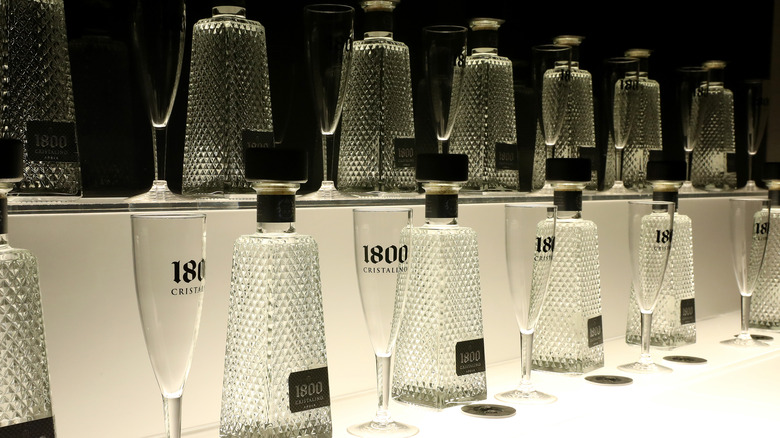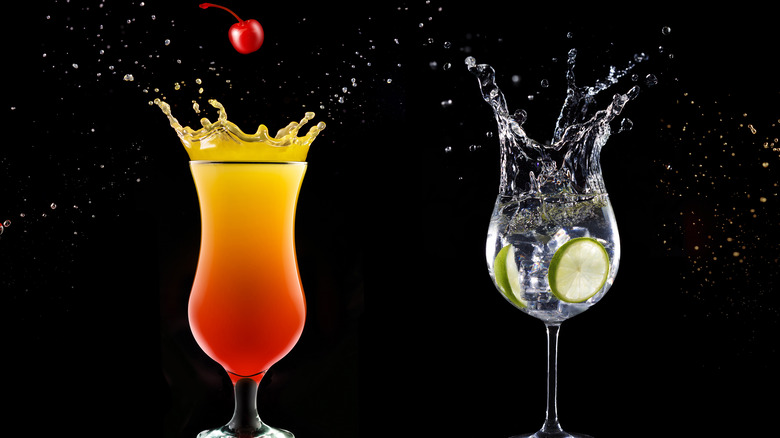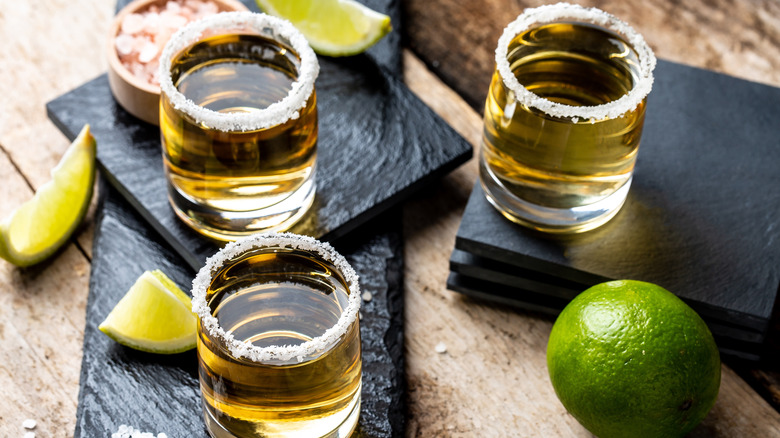What Is Cristalino Tequila And What Does It Taste Like?
Tequila is growing in popularity across the U.S. In fact, it's the fastest growing spirit category in the country (via Forbes), but previously we've mostly enjoyed blanco, reposado, and añejo tequila domestically. Now enter a new kind of tequila — or perhaps we should say a poorly kept secret drink from Mexico, cristalino. Cristalino is usually considered an añejo or extra añejo (for tequila newbies that means aged at least one to three years minimum). It is filtered until clear, usually using activated charcoal to produce a colorless product that is also enhanced in flavor. Distillers can create the product from blanco or reposado as well.
Cristalino's extra craftsmanship is part of its exclusivity, price, and appeal. This craftsmanship also yields a specific flavor profile unique to cristilano blends that is lighter, smoother, and typically more floral than other varieties. This aged smoothness could not be achieved without the filtration mentioned above.
Charcoal filtration yields crystal-clear tequila
You may have heard the adage about turning coal into diamonds, and in the case of tequila that would more correctly be charcoal into crystal-clear tequila. Without a highly effective filtration process, cristalino would simply be tequila. Described by distillers, when making a cristalino, they make sure their tequila is "triple-filtered with activated charcoal to remove the amber color." This process helps ensure cristalino is "very approachable for non-tequila drinkers and authentic enough for avid tequila drinkers. It finishes velvety smooth while maintaining the blanco's profile and tasting notes."
The use of charcoal in filtration can be seen as early as Tennessee whiskeys in charred oak barrels, but is more recognizable in a clear rum or vodka. The reason for this is that activated charcoal acts almost like a molecular super filter. How many times these tequilas are filtered through this process and the exact composition of the charcoal formula used will be dictated by the distillers, which are often propriety techniques. Each subtle difference will affect the flavors and aromas in the final product.
Cristalino has a distinct taste
Craftsmen take extreme pride in their product, and as they say, the "devil is in the details." "What makes our Cristalino different is that it's an 18-month-old Añejo, six months longer than industry requirements for Añejo tequilas. It's aged in American white oak ex-bourbon barrels resulting in a balanced and full spirit with an aroma of dark chocolate, subtle vanilla, and oak," described one cristalino distiller who works for Flecha Azul Tequila. The vanilla tones are a trademark of a good cristalino, according to tequila experts, so if you can't find this flavor in your drink, you may want to double-check the source. Cristalino should never taste woody or earthy like a mezcal.
In addition to the typical caramel and vanilla notes of a cristalino, different types of this spirit may also be highly floral or fruity and include flavors such as cinnamon, anise, melon, apple, or even marshmallow. Cristalino will make a smooth and sophisticated cocktail, but mixing one is a bit like mixing an exquisite whiskey with Coke — you can, but maybe you shouldn't.
Cristalino is different from standard tequila
Cristalino is essentially traditional tequila that meets modern technology. While the idea of charcoal filtration is old, the employment of activated charcoal in the cristalino process is relatively new. "Tequila is a very traditional spirit," says Karinna Enriquez Hurtado, master taster for Tequila Herradura (via Wine Mag). "We find some traditional tequila drinkers who maybe only drink blanco or reposado do not like cristalinos because producers are utilizing modern practices to create a new category."
Overall, however, cristalino is well-received by audiences for its extreme "sippability." Some describe cristalino as looking like a blanco but tasting more like a reposado or añejo, although others describe this product as having a flavor all its own. Despite these disagreements, it's widely agreed the product is smoother and sweeter than traditional distillations. In addition to filtration, the other main distinction of a cristalino is that aging is two months or longer, whereas a blanco is two months or less.
Cristalino's are inspiring a new generation of tequila drinkers and craft cocktails, so check out this hot new-to-us drink today!



